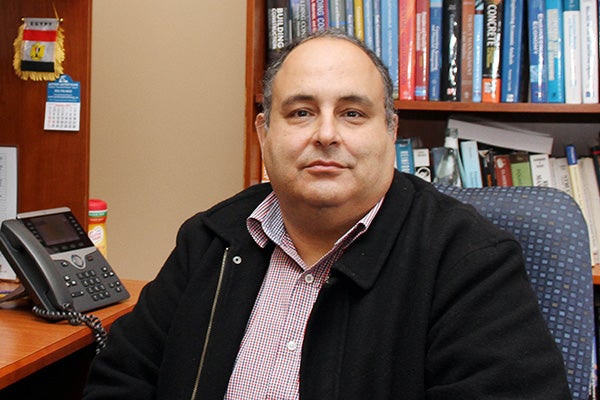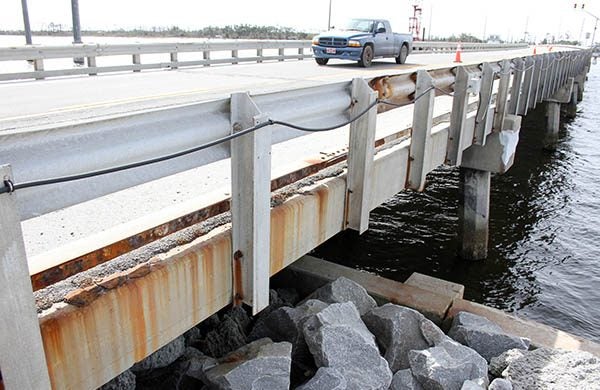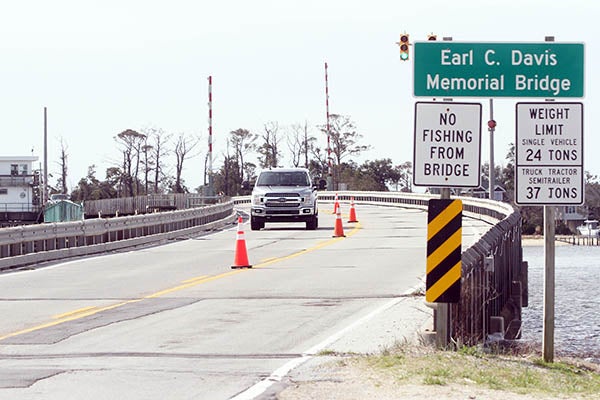ECU professor’s research could impact the future of bridge construction
An associate professor in East Carolina University’s Department of Construction Management is part of two research projects that could shape the way bridges are constructed in North Carolina.
Dr. Amin Akhnoukh is involved in projects that include the exploration of new water drainage systems as well as the state’s first fully composite reinforced bridge.
“It’s really exciting,” Akhnoukh said.

Dr. Amin Akhnoukh, associate professor in the East Carolina University Department of Construction Management, is conducting research that could impact how bridges are constructed in the future. (Photos by Ken Buday)
Bridges have traditionally been constructed with steel rebar and concrete. However, a new replacement bridge that is planned to link Harkers Island to mainland Carteret County will be built using non-corroding, carbon fiber-reinforced polymer strands instead of steel.
“There are a lot of corrosion issues for steel and a lot of concrete durability issues in the long term, so we are trying to design the first carbon fiber-reinforced bridge,” Akhnoukh said. “The sections will be smaller because carbon fiber sections are smaller than steel or concrete. It’s lighter, so there won’t be the need for heavy construction equipment. It’s safe in the long term because carbon fiber never corrodes.”
Akhnoukh is a co-principal investigator on the project, funded for $365,000 by the N.C. Department of Transportation for three years. Dr. Rudolf Seracino from N.C. State University is the principal investigator, with N.C. State’s Dr. Mohammad Pour-Ghaz and Dr. Giorgio Proestos serving as other investigators for the research. Seracino was involved in previous research that concluded that carbon fiber bridges would be a suitable structural replacement for steel and concrete bridges.
The issue is especially important along the coast, where the marine environment can lead to expensive maintenance costs and decrease the life span of bridges. The two bridges that link Harkers Island to the mainland are 45 years old. Sections of one of those bridges, the Earl C. Davis Memorial Bridge, are decorated with rust stains.
The new high-rise bridge will be better structurally, and repairs associated with corrosion in traditional steel reinforced concrete are eliminated, thus increasing the life span of the structure, Akhnoukh said.
“It’s stronger in the short term and better and more durable in the long term,” he said. “In general, it will be much better for the future. There will be lower maintenance costs.”

The Earl C. Davis Memorial Bridge to Harkers Island shows its age as a vehicle crosses. The bridge is scheduled to be replaced with the state’s first fully composite reinforced bridge.
Work on the grant is expected to start in August, correlating with the expected start of construction of the new $47.9 million bridge.
“This is a significant project for NCDOT because it will be our first complete structure reinforced with FRPs (fiber-reinforced polymer),” said Hon Yeung, project team lead for NCDOT. “ … FPRs are more expensive, but aside from the reduced long-term maintenance costs, there should be additional upfront cost savings in shipping, labor and equipment because the material is significantly lighter than steel. There will also be savings in not having to add certain admixtures into the concrete that typically would be required to help protect the steel reinforcement.”
The building of the bridge will provide the research team with an opportunity to quantify the mechanical characteristics of the materials used, and test and monitor the performance of the bridge from its earliest stages to operational use. The observations and data collected will serve as a benchmark for material specifications and design decisions for future carbon fiber-reinforced polymer bridges.
In a separate grant, Akhnoukh is the principal investigator in a $208,992 grant through NCDOT to look at bridge drainage systems.
Akhnoukh said current practices involve the implementation of drains or inlets in bridges that will whisk water away from the surface.

A vehicle crosses the Earl C. Davis Memorial Bridge at Harkers Island.
“Those inlets are very close to each other,” he said. “This results in high construction costs and high maintenance costs because of potential clogging and potential failure.”
Akhnoukh is working to come up with alternative guidelines for a new design for the drainage.
“We are surveying the other 50 DOTs, and we are surveying industry professionals,” he said. “We are beginning to study bridge codes and trying to see if there are any new inventions in the market or any new products that will enable us to create much bigger spacing for the inlets.”
Work on the two-year grant started in January. Dr. Carol Massarra, assistant professor in the Department of Construction Management, and Seracino are other investigators on the research team, with assistance from one undergraduate student.
In the end, better bridges will save money for taxpayers.
“In general, a newer bridge will possibly require less expenditure up front and maintenance cost going forward,” Akhnoukh said.